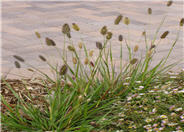
Common name:Common Yarrow, Mifoil
Botanical name:Achillea millefolium
Common Yarrow is a hardy perennial with hairy, evergreen green foliage. It has a tight cluster of white flowers and typically blooms in the summer months. It attracts bees and butterflies. It prefers full to part sun and becomes drought tolerant once it's established. Following bloom, one should dead head the plant and divide the clumps when it appears crowded to keep it looking tidy.

Common name:Bitsy Daylily
Botanical name:Hemerocallis 'Bitsy'
This dependable perennial has thin, strap-like, grass-like leaves reaching 12"-18" tall. Bright yellow flowers, resembling lilies, are high above the foliage, making the overall height of this plant at 24" tall. Blooms appear in spring through fall, thus making this Hemerocallis variety very popular. It needs regular watering and more during hot summer months. It prefers full sun or light shade and will tolerate seaside conditions.

Common name:Trident Maple
Botanical name:Acer buergerianum
The Trident Maple is a small deciduous tree growing to 20' tall and wide, bearing small, 3' lobed leaves noted for brilliant, reliable red-orange and deep salmon pink fall color. The bark quickly becomes greyish, and this is the most popular maple for
bonsai in Japan, being especially valued for its beautiful surface roots. Depending on the severity of the summer, it should receive sun to mostly shade. with average watering. -Monterey Bay Nursery

Common name:Red Bunny Tails
Botanical name:Pennisetum messiacum
This clumping Pennisetum is most effectively used in mass plantings where the dark, almost black flowers can wave in the wind. Although originally thought to be an evergreen, it goes semi-dormant in most climates in Southern CA. It requires moderate water through the summer. It grows to 2' tall and 2' wide. It should be cut back annually to promote fresh growth. It should not be planted near natural areas.
Photographer: GardenSoft
Incorporate compost 6" into your soil to retain water, reduce compaction, feed earthworms, and provide valuable nutrients to your plants.
Develop healthy soil for plants that are vigorous and naturally pest-resistant.